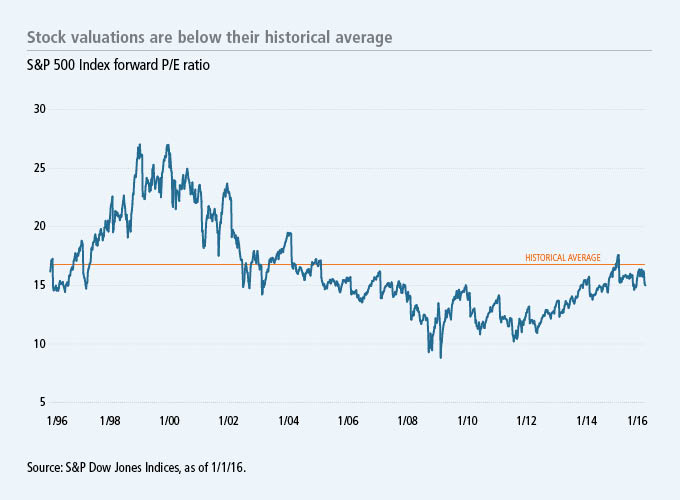U.S. large-cap stocks are on sale following the market pullback
In a dramatic move, the S&P 500 Index has declined nearly 10% since the beginning of 2016, but given our outlook for a stable U.S. economy, we believe the correction has effectively put high-quality U.S. large-cap stocks on sale.

We believe the sharp drawdown is an overreaction to the sentiment-driven noise surrounding a Chinese slowdown, as well as a continued decline in commodity prices. While global markets remain unstable, share price volatility has far exceeded the volatility of the underlying business prospects for many top companies.
Putting the pullback in historical context
The S&P 500 Index is now trading at 14x forward earnings, versus the 20-year average of 16x.1 Combine these valuations with steady U.S. economic conditions, and we believe that this is an extremely attractive environment for stock pickers like us. In fact, we believe our portfolios are currently trading at a 10% to 15% discount to traditional valuations.

We'd echo the sentiment of analysts who have pointed out the key differences between this market environment and that of 2007/2008. The chief difference is the strength of the consumer, who today is benefiting from lower oil prices, strong job creation, and an improving housing market. Another key difference today is that large U.S. banks are sporting their strongest balance sheets in decades. Consumer and financial leverage is also down significantly from previous peaks, which makes it unlikely that the economy would face a potential debt-fueled financial crisis.
Positioning and opportunity
Within our portfolios, we continue to be positioned for improved U.S. economic conditions and hold sector overweights in financials, including large banks, asset managers, and capital markets; consumer discretionary, including online retailers, home builders, and home improvement; and information technology, including new areas of innovation such as online advertising and smartphones. Conversely, we're underweight in more defensive sectors such as healthcare, consumer staples, utilities, and telecommunication services, which we believe are either fully valued or offer lower-quality investment opportunities.
Although the market drawdown has admittedly been fast and furious, we're not surprised at some of the negative price movements experienced by several of our holdings, especially the big winners of the past year. We can recall instances of quality companies that have gone temporarily out of favor only to come roaring back to new highs when the market's focus returns to company fundamentals and business quality. A case in point is one of our long-time holdings that more than doubled last year, but is a little slower out of the gate this year. We believe the company is likely to produce improved operating margins, while top-line growth remains robust.
Large U.S. banks, which we estimate are currently trading at 55 cents to 60 cents on the dollar, are well positioned to benefit from rising interest rates, a gradually improving U.S. economy, a sustained housing expansion, significant cost cuts, and dividends that may be poised to rise significantly. While bank stocks have seen a weak start to 2016 amid uncertainty about the pace of U.S. Federal Reserve interest-rate hikes, most of our holdings have released solid earnings reports, which gives us more faith in the strength of their business fundamentals.
Patience should be rewarded in the long term
January's market correction was either a signal that bleak times are around the corner for the U.S. economy or it represents a buying opportunity for discerning long-term investors. Our view is that the economy will continue to grind out gains and that our core strategies own quality businesses with competitive advantages that continue to compound value. And now, we believe the companies in our portfolio are on sale at 60 cents to 65 cents on the dollar. With a stable U.S. economy, a healthy consumer, and a financially sound banking system as a backdrop, we see bright prospects for further accretion ahead. We don't believe a U.S. recession is on the near-term horizon, and we're optimistic about the opportunities that these quality companies currently offer investors.
1 S&P Down Jones Indices, as of January 2016.
Important disclosures
Important disclosures
The S&P 500 Index tracks the performance of 500 of the largest publicly traded companies in the United States. It is not possible to invest directly in an index. Forward price-to-earnings (P/E) ratio is a stock valuation measure comparing the current share price of a stock to the underlying company's estimated earnings per share over the next 12 months. Past performance does not guarantee future results.
Large company stocks could fall out of favor, and value stocks may decline in price. Foreign investing, especially in emerging markets, has additional risks, such as currency and market volatility and political and social instability. The use of hedging and derivatives could produce disproportionate gains or losses and may increase costs.
MF273411






